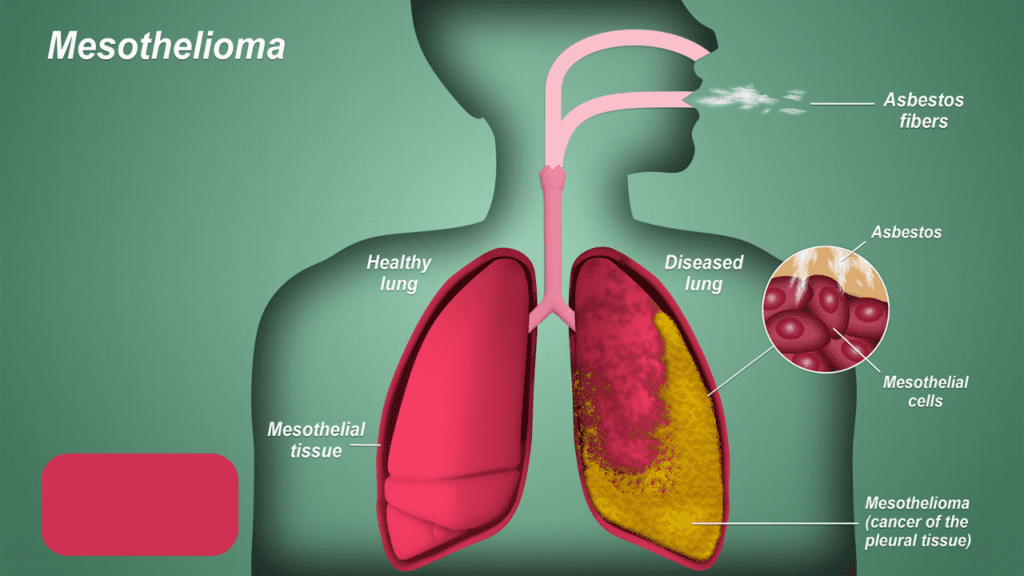Mesothelioma Meaning in English
Table of Contents
What is Mesothelioma Asbestos Cancer
Mesothelioma, often referred to as asbestos cancer, is a malignant tumor that develops in the mesothelium, the protective lining that covers many internal organs. The primary cause of mesothelioma is exposure to asbestos, a group of minerals made of microscopic fibers that were widely used in construction, insulation, and other industries due to their resistance to heat, fire, and chemicals.
Types of Mesothelioma:
- Pleural Mesothelioma: Affects the lining of the lungs (pleura). It is the most common form.
- Peritoneal Mesothelioma: Affects the lining of the abdomen (peritoneum).
- Pericardial Mesothelioma: Affects the lining around the heart (pericardium).
- Testicular Mesothelioma: Affects the lining around the testes (tunica vaginalis).
Symptoms:
- Pleural Mesothelioma: Shortness of breath, chest pain, persistent cough, fatigue, weight loss.
- Peritoneal Mesothelioma: Abdominal pain and swelling, nausea, weight loss.
- Pericardial Mesothelioma: Chest pain, heart palpitations, shortness of breath.
- Testicular Mesothelioma: Swelling or lumps in the testes, pain.
Causes:
- Asbestos Exposure: Inhalation or ingestion of asbestos fibers, which can become lodged in the mesothelium. Over time, these fibers cause inflammation and scarring, leading to cellular damage and cancer development.
Risk Factors:
- Occupational exposure (construction workers, miners, shipyard workers, etc.).
- Living in areas with high environmental asbestos levels.
- Secondary exposure (family members of asbestos workers).
Diagnosis and Treatment:
- Diagnosis: Imaging tests (X-rays, CT scans), biopsies, and blood tests.
- Treatment: Surgery, chemotherapy, radiation therapy, targeted therapy, and palliative care to manage symptoms.
Mesothelioma is a particularly aggressive and challenging cancer to treat, often diagnosed at a late stage due to its long latency period (20-50 years after exposure). Early detection and treatment are crucial for improving patient outcomes.
Mesothelioma Meaning in English
Mesothelioma is a type of cancer that develops from the mesothelium, the thin layer of tissue that covers many of the internal organs. It most commonly affects the lining of the lungs (pleura) but can also occur in the lining of the abdomen (peritoneum), the heart (pericardium), or the testes (tunica vaginalis). The primary cause of mesothelioma is exposure to asbestos fibers. Symptoms may include shortness of breath, chest pain, and abdominal swelling. Mesothelioma is a serious and aggressive form of cancer, often diagnosed at an advanced stage.
Mesothelioma Affects What Part of the Body

Mesothelioma primarily affects the mesothelium, the thin layer of tissue that covers and protects most internal organs. Depending on the type of mesothelioma, different parts of the body can be affected:
- Pleural Mesothelioma: Affects the pleura, the lining of the lungs and the chest cavity. This is the most common type of mesothelioma.
- Peritoneal Mesothelioma: Affects the peritoneum, the lining of the abdominal cavity.
- Pericardial Mesothelioma: Affects the pericardium, the lining around the heart.
- Testicular Mesothelioma: Affects the tunica vaginalis, the lining around the testes. This is the rarest form of mesothelioma.
Each type affects its respective lining and can cause symptoms specific to that area of the body.
Papillary Mesothelioma Pathology Outlines
Papillary mesothelioma, also known as well-differentiated papillary mesothelioma (WDPM), is a rare subtype of mesothelioma that generally has a better prognosis than other forms. It most commonly affects the peritoneum but can also occur in the pleura and other mesothelial surfaces.
Histopathology:
- Papillary Structures: Characterized by well-formed papillary structures lined by a single layer of bland mesothelial cells.
- Uniform Cells: The cells are typically uniform with minimal cytological atypia.
- Stroma: The papillae are often supported by delicate fibrovascular cores.
- Low Mitotic Rate: These tumors generally have a low mitotic rate, indicating slow cell division.
Immunohistochemistry:
- Mesothelial Markers: Positive for markers such as calretinin, WT-1, cytokeratin 5/6, and D2-40.
- Epithelial Markers: May show positivity for epithelial markers like EMA (epithelial membrane antigen).
- Negative Markers: Typically negative for markers that are positive in adenocarcinomas, such as CEA (carcinoembryonic antigen), Ber-EP4, and MOC-31.
Clinical Features:
- Demographics: More commonly found in younger patients and women.
- Symptoms: Often asymptomatic, but can present with abdominal pain or swelling in peritoneal cases, or chest pain and pleural effusion in pleural cases.
- Prognosis: Generally has a favorable prognosis compared to other types of mesothelioma, with many patients having a long-term survival. However, it requires careful monitoring due to the potential for recurrence or transformation into more aggressive forms.
Differential Diagnosis:
- Reactive Mesothelial Proliferations: Can be distinguished from benign reactive mesothelial proliferations by the presence of well-formed papillary structures and immunohistochemical profile.
- Other Mesotheliomas: Distinguished from more aggressive mesotheliomas by its histological appearance and lower cellular atypia.
- Adenocarcinomas: Differentiated by immunohistochemical staining patterns and the absence of significant cytological atypia.
Treatment:
- Surgical Resection: Often the primary treatment, especially in localized cases.
- Monitoring: Regular follow-up and monitoring due to the risk of recurrence.
Papillary mesothelioma is rare, and its management and prognosis can vary, so consultation with a specialist in mesothelioma is often recommended.
Mesothelioma IHC Pathology Outlines
Immunohistochemistry (IHC) is a critical tool in the diagnosis and differentiation of mesothelioma from other tumors, particularly adenocarcinomas. IHC involves the use of antibodies to detect specific antigens in the cells of a tissue section. Here are the common IHC markers used in the diagnosis of mesothelioma:
Positive Markers for Mesothelioma:
- Calretinin: A calcium-binding protein commonly positive in mesothelioma.
- WT-1 (Wilms’ Tumor 1): A nuclear protein expressed in mesothelial cells.
- Cytokeratin 5/6 (CK5/6): Intermediate filament proteins found in mesothelial cells.
- D2-40 (Podoplanin): A membrane glycoprotein.
- Mesothelin: A cell surface protein expressed in mesothelial cells.
- Vimentin: An intermediate filament protein found in mesenchymal cells, including mesothelial cells.
Negative Markers for Mesothelioma (Markers to Rule Out Adenocarcinoma):
- CEA (Carcinoembryonic Antigen): Usually negative in mesothelioma but positive in adenocarcinoma.
- Ber-EP4: An epithelial marker often positive in adenocarcinoma.
- MOC-31: An epithelial marker often positive in adenocarcinoma.
- B72.3: Often positive in adenocarcinoma.
- CD15 (Leu-M1): Positive in adenocarcinoma.
- TTF-1 (Thyroid Transcription Factor-1): Positive in lung adenocarcinoma.
- Napsin A: Positive in lung adenocarcinoma.
Common Panels for Diagnosing Mesothelioma:
- Mesothelial Markers Panel:
- Calretinin
- WT-1
- CK5/6
- D2-40
- Mesothelin
- Epithelial Markers Panel:
- CEA
- Ber-EP4
- MOC-31
- B72.3
- TTF-1 (for lung origin)
- Napsin A (for lung origin)
Histological Subtypes and Their IHC Profiles:
- Epithelioid Mesothelioma:
- Most common subtype.
- Typically shows strong positivity for calretinin, WT-1, CK5/6, and D2-40.
- Sarcomatoid Mesothelioma:
- Less common, more aggressive.
- Shows positivity for vimentin and may be negative for some mesothelial markers like calretinin.
- Biphasic Mesothelioma:
- Contains both epithelioid and sarcomatoid components.
- IHC will show a mix of markers for both subtypes.
Additional Diagnostic Considerations:
- Clinical History: Including exposure to asbestos.
- Radiological Findings: Consistent with mesothelioma.
- Histopathological Examination: To confirm mesothelioma and differentiate from other tumors.
IHC is essential for the accurate diagnosis of mesothelioma, helping to distinguish it from other malignancies, particularly adenocarcinomas, through the use of specific positive and negative markers. The combination of clinical, radiological, and histopathological data, along with IHC, provides a comprehensive approach to diagnosing mesothelioma.
Treatment of Mesothelioma

The treatment for mesothelioma depends on several factors, including the stage of the disease, the type of mesothelioma, the location of the tumor, and the overall health of the patient. Treatment options typically include a combination of surgery, chemotherapy, radiation therapy, and palliative care. Here is an overview of the main treatment approaches:
1. Surgery:
Surgical options aim to remove as much of the cancer as possible and may include:
- Extrapleural Pneumonectomy (EPP): Removal of the affected lung, part of the diaphragm, the pleura, and often part of the pericardium.
- Pleurectomy/Decortication (P/D): Removal of the pleura lining the lung and chest cavity, and sometimes parts of the diaphragm and pericardium, without removing the entire lung.
- Cytoreductive Surgery: Often combined with hyperthermic intraperitoneal chemotherapy (HIPEC) for peritoneal mesothelioma.
2. Chemotherapy:
Chemotherapy uses drugs to kill cancer cells or stop them from growing and is often used in conjunction with surgery.
- Pemetrexed (Alimta) and Cisplatin: The standard chemotherapy regimen for mesothelioma.
- Carboplatin: Sometimes used as an alternative to cisplatin, particularly in patients who cannot tolerate cisplatin.
3. Radiation Therapy:
Radiation therapy uses high-energy rays to target and kill cancer cells.
- External Beam Radiation Therapy (EBRT): Commonly used after surgery to eliminate residual cancer cells.
- Intensity-Modulated Radiation Therapy (IMRT): Allows for more precise targeting of the tumor, sparing healthy tissue.
4. Immunotherapy:
Immunotherapy helps the body’s immune system fight cancer. This is an emerging treatment option for mesothelioma.
- Checkpoint Inhibitors: Drugs like pembrolizumab (Keytruda) and nivolumab (Opdivo) are being studied and used in some cases to enhance the immune response against mesothelioma cells.
5. Targeted Therapy:
Targeted therapy focuses on specific molecules involved in cancer growth and progression.
- Clinical Trials: Ongoing research is investigating various targeted therapies for mesothelioma.
6. Palliative Care:
Palliative care focuses on relieving symptoms and improving quality of life for patients with advanced mesothelioma.
- Pain Management: Using medications and other therapies to control pain.
- Pleurodesis: A procedure to prevent the buildup of fluid in the chest cavity.
- Paracentesis: Removal of fluid from the abdomen in cases of peritoneal mesothelioma.
7. Multimodal Therapy:
Often, a combination of the above treatments is used to maximize effectiveness. This approach is tailored to the individual patient’s needs and the specifics of their disease.
Clinical Trials:
Participation in clinical trials may provide access to new and experimental treatments that are not yet widely available.
Follow-Up and Monitoring:
Regular follow-up is crucial to monitor for recurrence and manage any ongoing symptoms or side effects from treatment.
The treatment of mesothelioma typically involves a multidisciplinary approach, combining surgery, chemotherapy, radiation therapy, and supportive care to improve outcomes and quality of life. Early detection and a personalized treatment plan are essential for the best possible prognosis.
Click Here for more details
Click Here for more Information
Mesothelioma Meaning in English Mesothelioma Meaning in English Mesothelioma Meaning in English Mesothelioma Meaning in English Mesothelioma Meaning in English Mesothelioma Meaning in English Mesothelioma Meaning in English Mesothelioma Meaning in English Mesothelioma Meaning in English Mesothelioma Meaning in English Mesothelioma Meaning in English Mesothelioma Meaning in English Mesothelioma Meaning in English Mesothelioma Meaning in English Mesothelioma Meaning in English Mesothelioma Meaning in English


